Inverse Functions
Overview
• Invertability.
• Definition of an Inverse Function.
• Expressions and Inverses .
• Basic Inverses Examples.
• Graphs and Inverses .
• The Horizontal Line Test .
• Graphin an Inverse.
• Machines and Inverses.
Invertability
In section 2.1, we determined whether a relation was a function by looking
for duplicate x- values .
Invertability is the opposite. A function is invertible if and only if it
contains no two ordered pairs with the
same y-values, but different x -values. Thus, to determine if a function is
invertible, we look for duplicate y-values. Invertible functions are also
called one-to-one.
Example
Which functions are invertible?
f = {(3, 3), (5, 9), (6, 3)}
g = {(1, 2), (2, 3), (4, 5)}
h = {(3, 7), (4, 4), (7, 3)}
f is not invertible since it contains both (3, 3) and (6, 3).
g is invertible.
h is invertible.
Definition of an Inverse Function
If f is an invertible function, its inverse, denoted f-1, is the set
of ordered pairs (y, x) such that (x, y) is in f.
That is, f-1 is f with its x- and y- values swapped . f-1(x) is not 1/f(x).
Example
Find the inverses of the invertible functions from the last example.
Solution
g-1 = {(2, 1), (3, 2), (5, 4)}
h-1 = {(7, 3), (4, 4), (3, 7)}
Note
1. Invertability insures that the a function’s inverse
is a function.
2. A function can be its own inverse. Observe how the function h in
the last example has this property.
3. Whenever g is f’s inverse then f is g’s inverse also.
4. Inversion swaps domain with range. That is
dom f = ran f-1
ran f = dom f-1
Expressions and Inverses
Example
Describe in words what the function f(x) = x does to its input.
Solution
Nothing.
The Cancellation Theorem
Functions f are g are inverses of each other if and only
if both of the following cancellation laws hold :
(f o g)(x) = x for all x in dom g
(g o f)(x) = x for all x in dom f
In other words, the machines f o g and g o f do nothing
to their inputs. This means that f reverses all changes
made by g and vise versa. In essence, f and g cancel each other out.
Example
Verify that the following pairs are inverses of each other.

Solution

Since this cannot be simplified into x , we may stop and conclude that f and g are not inverses.

Even though the first one worked, they both have to work.
So we conclude that f and g are not
inverses of each other.
Example
If f(–7) = 8, and f is invertible, solve 1/2f(x–9) = 4.
Solution
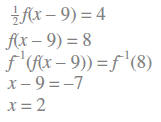
Let f and g be inverses of each other, and let f(x) = y.
Then by the Cancellation Theorem
g(y) = g(f(x)) = x
This partly proves the next theorem.
Change of Form Theorem
Functions f and g are inverses of each other if and only if both of the
following change of form laws holds:
f(x) = y implies g(y) = x
g(x) = y implies f(y) = x
Change of Form Theorem (alternate version)
If f is invertible then
f(x) = y if and only if f-1(y) = x
Example
If f(4) = 3, f(3) = 2, and f is invertible, find f-1(3) and (f(3))-1.
Solution

To find the inverse of a function, f, algebraically
1. Set y = f(x).
2. Swap x with y.
3. Solve for y .
4. Replace y with f-1(x).
Example
Find the inverses of

Solution
a)
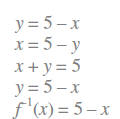
Notice that f is its own inverse.
b)
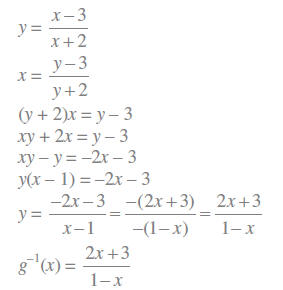
Basic Inverses Examples
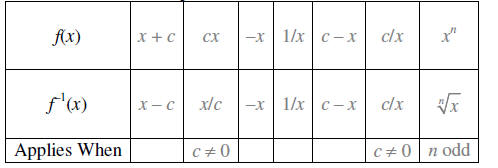
Graphs and Inverses
To find f-1(a) from the graph of f, start by
finding a on the y-axis and move horizontally until you hit the
graph. The answer is the x-value of the point you hit.
| Example Use the graph of f to find f-1(2) and f-1(3). Solution f-1(2) = 3 f-1(3) = 3.6 |
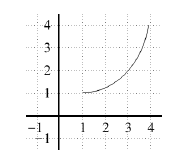 |
The Horizontal Line Test
The graph of a function is that of an invertible function
if and only if every horizontal line passes through no
or exactly one point.
Example
Which graph is that of an invertible function?
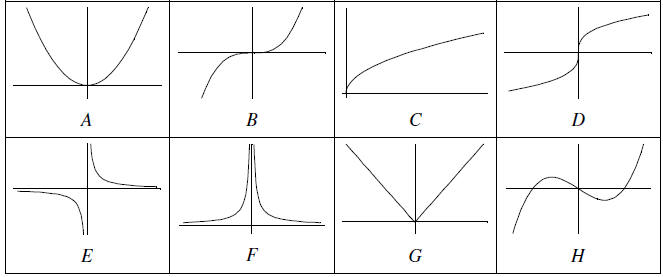
Solution
B, C, D, and E
Graphing an Inverse
To graph f-1 given the graph of f, we
place a point (b, a) on the graph of f-1 for every point (a, b) on
the graph
of f. This has the effect of reflecting the
graph of f across the line y = x.
Example
a) Which pair of functions in the last example are inverses of each other?
b) Which function is its own inverse?
c) Which function is invertible but its inverse is not one of those shown?
Solution
B and D are inverses of each other.
E is its own inverse.
C is invertible, but its inverse is not shown.
| To graph f-1
given the graph of f, do the following 1. Label several points (a, b) on f that define its general shape. 2. For each, plot (b, a). 3. Draw the line y = x. 4. Connect the dots paying attention to the way the graph is being reflected across y = x. Example |
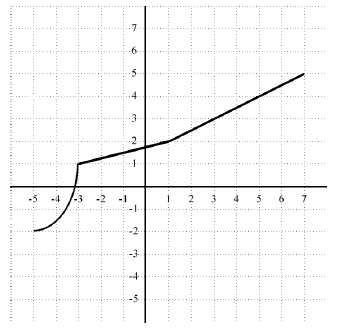 |
Machines and Inverses
From a machine perspective, a function f is invertible if
and only if it is a composition of invertible
operations (CIO). In this case, f-1 is the machine that performs
the opposite operations in the opposite order
(4O). When a function is a CIO, the machine metaphor is a quick and easy
way to find its inverse. I will
teach you how to do it using a machine table, and I may require you to show a
machine table because
otherwise there is no work to show. However, that is the point. With some
practice, you can use this method
to find inverses in your head.
Example
Make a machine table for each function. If it is invertible find its inverse
using the machine table.

 where k is the function graphed to the right.
where k is the function graphed to the right.
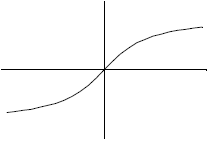
Solution
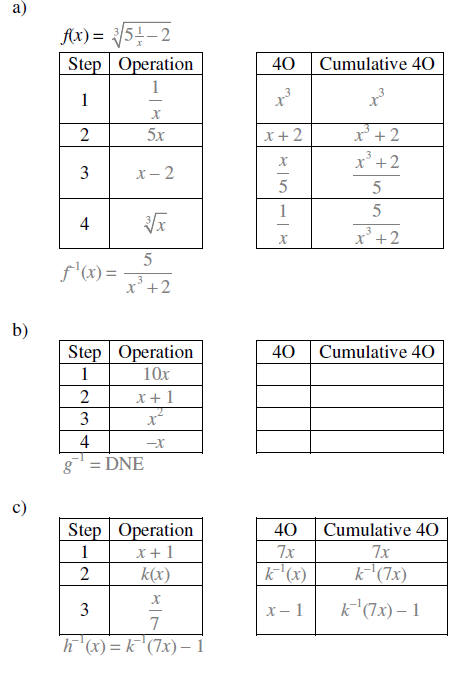
| Prev | Next |